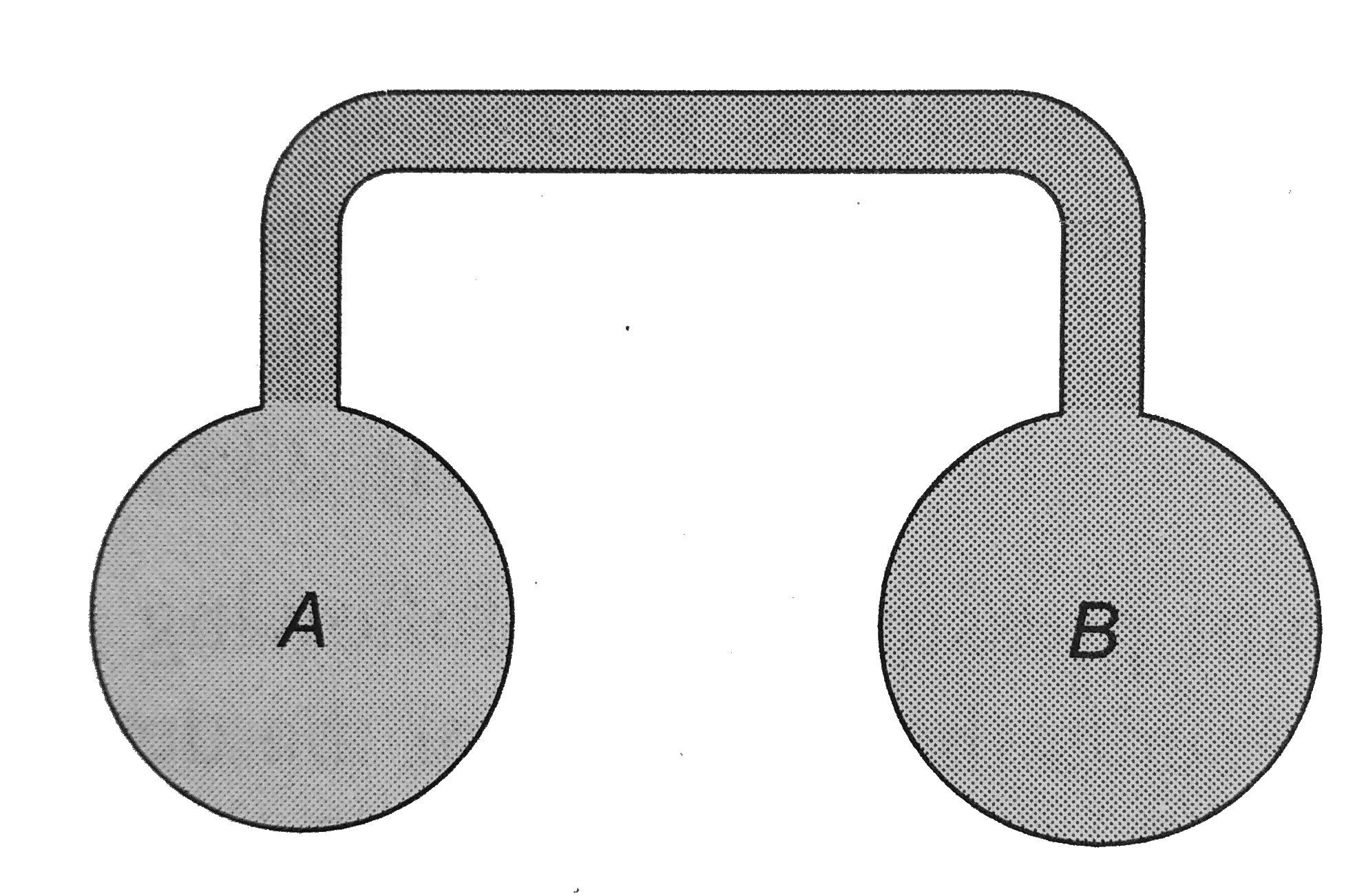Equal masses of air are sealed in two vessels, one of volume and the other of volume . If the first vessel is maintained at a temperature and the other at , find the ratio of the pressures in the two vessels.
To find the ratio of the pressures in the two vessels, we can use the ideal gas law, which states that for a given mass of gas, the relationship between pressure (P), volume (V), and temperature (T) is given by the equation:
PV=nRT
Where:
- P = Pressure
- V = Volume
- n = Number of moles of gas
- R = Universal gas constant
- T = Temperature in Kelvin
1. Identify the Variables:
- For vessel 1 (volume V0, temperature T1=300K):
- V1=V0
- T1=300K
- Pressure P1 (unknown)
- For vessel 2 (volume 2V0, temperature T2=600K):
- V2=2V0
- T2=600K
- Pressure P2 (unknown)
2. Use the Ideal Gas Law:
Since the masses of air are equal in both vessels, the number of moles n will be the same for both. We can write the ideal gas equation for both vessels:
P1V1=nRT1(1)
P2V2=nRT2(2)
3. Set Up the Ratio:
Dividing equation (1) by equation (2):
P1V1P2V2=nRT1nRT2
This simplifies to:
P1P2=V2V1⋅T1T2
4. Substitute the Known Values:
Substitute V1=V0, V2=2V0, T1=300K, and T2=600K:
P1P2=2V0V0⋅300600
5. Simplify the Expression:
The V0 terms cancel out:
P1P2=2⋅300600
Simplifying further:
P1P2=2⋅12=1
6. Conclusion:
The ratio of the pressures in the two vessels is:
P1:P2=1:1
- P = Pressure
- V = Volume
- n = Number of moles of gas
- R = Universal gas constant
- T = Temperature in Kelvin
- For vessel 1 (volume V0, temperature T1=300K):
- V1=V0
- T1=300K
- Pressure P1 (unknown)
- For vessel 2 (volume 2V0, temperature T2=600K):
- V2=2V0
- T2=600K
- Pressure P2 (unknown)
Since the masses of air are equal in both vessels, the number of moles n will be the same for both. We can write the ideal gas equation for both vessels:
P1V1=nRT1(1)
P2V2=nRT2(2)
Dividing equation (1) by equation (2):
P1V1P2V2=nRT1nRT2
This simplifies to:
P1P2=V2V1⋅T1T2
Substitute V1=V0, V2=2V0, T1=300K, and T2=600K:
P1P2=2V0V0⋅300600
The V0 terms cancel out:
P1P2=2⋅300600
Simplifying further:
P1P2=2⋅12=1
The ratio of the pressures in the two vessels is:
P1:P2=1:1
Topper's Solved these Questions
- KINETIC THEORY OF GASES AND FIRST LAW OF THERMODYNAMICSBook:CENGAGE PHYSICS ENGLISHChapter:KINETIC THEORY OF GASES AND FIRST LAW OF THERMODYNAMICSExercise:Exercise 2.2
Explore 28 Videos
- KINETIC THEORY OF GASES AND FIRST LAW OF THERMODYNAMICSBook:CENGAGE PHYSICS ENGLISHChapter:KINETIC THEORY OF GASES AND FIRST LAW OF THERMODYNAMICSExercise:Subjective
Explore 22 Videos
- KINETIC THEORY OF GASES AND FIRST LAW OF THERMODYNAMICSBook:CENGAGE PHYSICS ENGLISHChapter:KINETIC THEORY OF GASES AND FIRST LAW OF THERMODYNAMICSExercise:Solved Examples
Explore 14 Videos
- KINETIC THEORY OF GASESBook:CENGAGE PHYSICS ENGLISHChapter:KINETIC THEORY OF GASESExercise:Compression
Explore 2 Videos
- LINEAR AND ANGULAR SIMPLE HARMONIC MOTIONBook:CENGAGE PHYSICS ENGLISHChapter:LINEAR AND ANGULAR SIMPLE HARMONIC MOTIONExercise:Single correct anwer type
Explore 14 Videos
Similar Questions
Two closed vessels of equal volume containing air at pressure P1 and temperature T1 are connected to each other through a narrow tube. If the temperature in one of the vessels is now maintained at T1 and that in the other at T2, what will be the pressure in the vessels?
View SolutionTwo closed vessels of equal volume containing air at pressure P1 and temperature T1 are connected to each other through a narrow tube. If the temperature in one of the vessels is now maintained at T1 and that in the other at T2, what will be the pressure in the vessels?
View Solution2g of hydrogen is sealed in a vessel of volume 0.02m3and is maintained at 300K. Calculate the pressure in the vessel.
View SolutionEqual masses of the two gases A and B are kept in two separate vessels at the same temperature and pressure. If the ratio of the molecular masses of A and B is 2:3, find the ratio of the volumes of the two vessels.
View SolutionGeeta pours in equal amount of milk into two different vessels. One vessel is 47 th full and the other is 38 th full. Find the ratio of the volumes of the two vessels.
View SolutionA vessel of volume V is divided into two parts by a partition. The pressure of the gas in one part is p1 and that in the other part is p2. If the partition is removed find the pressure of the gas in the vessel.
View SolutionA vessel contains 1.60g of oxygen and 2.80g of nitrogen. The temperature is maintained at 300K and the voume of the vessel is 0.166m3. Find the pressure of the mixture.
View SolutionA vessel of volume 2000cm3 contains 0.1mol of oxygen and 0.2mol of carbon dioxide. If the temperature of the mixture is 300K, find its pressure.
View SolutionTwo identical vessels contain two different ideal gases at the same temperature. If the average speed of gas molecules in the first vessel is euqal to the most probable speed of molecules in the second vessel, then the ratio of the mass of gas molecules in the first vessel to that in the second vessel is
View SolutionTwo spherical vessel of equal volume are connected by a n arrow tube. The apparatus contains an ideal gas at one atmosphere and 300K. Now if one vessel is immersed in a bath of constant temperature 600K and the other in a bath of constant temperature 300K. then the common pressure will be

View Solution